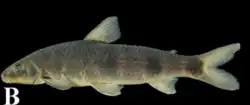Hypomasticus mormyrops
| Hypomasticus mormyrops | |
|---|---|

| |
| Scientific classification | |
| Kingdom: | Animalia |
| Phylum: | Chordata |
| Class: | Actinopterygii |
| Order: | Characiformes |
| Family: | Anostomidae |
| Genus: | Hypomasticus |
| Species: | H. mormyrops
|
| Binomial name | |
| Hypomasticus mormyrops (Steindachner, 1875)
| |
| Synonyms[2] | |
| |
Hypomasticus mormyrops is a species of freshwater ray-finned fish belonging to the family Anostomidae, the toothed headstanders. This fish is endemism to southeastern Brazil.
Taxonomy
Hypomasticus mormyrops was first formally described as Leporinus mormyrops in 1875 by the Austrian ichthyologist Franz Steindachner with its type locality given as the Río Parahyba and the Río Piabanha in Brazil.[2] In 1929 the Russian-American ichthyologist Nikolai Andreyevich Borodin proposed the new genus Hypomasticus for some species previously classified in Leporinus and designated L. mormyrops as its type species. The genus Hypomasticus is classified within the subfamily Leporininae of the toothed headstander family, Anostomidae.[3] Anostomidae is classified in the suborder Characoidei of the order Characiformes, the characins and related fishes.[4]
Etymology
Hypomasticus mormyrops is the type species of the genus Hypomasticus, a name which prefixes hypo-, meaning "under" with masticus, which is derived from the Greek mastax, meaning "that with which one chews" or, in other words, the mouth. This is an allusion to the mouth of this species being under the snout, or inferior. The specific name, mormyrops, means smiliar to the African freshwater elephantfish genus Mormyrus, a reference to these tawo taxa having similar fleshy snouts.[5]
Description
Hypomasticus mormyrops has three dark blotches on the sides of the body, four teeth on each premaxilla and dentary and the caudal peduncle has a count of 12 scale rows around it.[6] This species has a fleshy snout and inferior mouth,[5] and reaches a maximum standard length of 21.2 cm (8.3 in).[7]
Distribution and habitat
Hypomasticus mormyrops is endemic to Brazil where it is found in the dtainage systems of the Paraíba, Piabanha, Doce and Jequitinhonha rivers and in the coastal river systems between the Paraíba do Sul, São Paulo and Rio de Janeiro rivers, and Jucuruçu. It has been recorded from the states of Bahia, Espírito Santo, Minas Gerais, Rio de Janeiro and São Paulo. This species is commonest in stretches ofriver with rocky bottoms.[1]
References
- ^ a b Instituto Chico Mendes de Conservação da Biodiversidade (ICMBio) (2021). "Hypomasticus mormyrops". IUCN Red List of Threatened Species (in Portuguese). 2021: e.T187341A1826734. doi:10.2305/IUCN.UK.2021-1.RLTS.T187341A1826734.pt. Retrieved 27 July 2025.
- ^ a b Eschmeyer, William N.; Fricke, Ron & van der Laan, Richard (eds.). "Species in the genus Hypomasticus". Catalog of Fishes. California Academy of Sciences. Retrieved 27 July 2025.
- ^ Eschmeyer, William N.; Fricke, Ron & van der Laan, Richard (eds.). "Genera in the family Leporininae". Catalog of Fishes. California Academy of Sciences. Retrieved 27 July 2025.
- ^ Richard van der Laan; William N. Eschmeyer; Ronald Fricke. "Eschmeyer's Catalog of Fishes Classification". Eschmeyer's Catalog of Fishes. California Academy of Sciences. Retrieved 27 July 2025.
- ^ a b Christopher Scharpf (4 May 2025). "Family ANOSTOMIDAE Günther 1864 (Toothed Headstanders)". The ETYFish Project Fish Name Etymology Database. Christopher Scharpf. Retrieved 27 July 2025.
- ^ Jose Birindelli; Bruno Melo; Luis Silva; Debora Diniz; and Claudio Oliveira (202). "A New Species of Hypomasticus from Eastern Brazil Based on Morphological and Molecular Data (Characiformes, Anostomidae)". Copeia. 108 (2): 416–425. doi:10.1643/CI-19-335. hdl:11449/195539.
- ^ Froese, Rainer; Pauly, Daniel (eds.). "Hypomasticus mormyrops". FishBase. April 2025 version.
